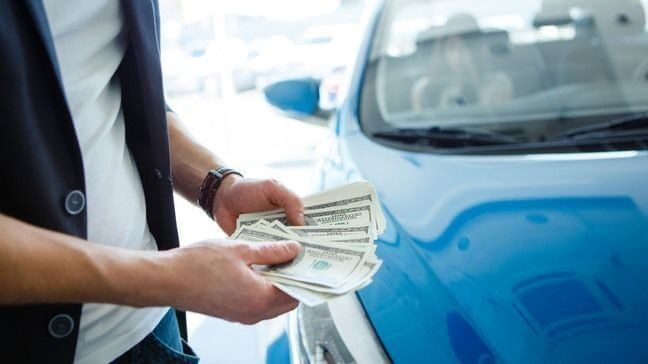Finance
How Much Should A Car Down Payment Be?

Automobile purchase is a big investment, and not just in money. Buying a car means also taking on the responsibility of maintaining it every day and dealing with the sometimes-endless repairs that come with them. If you’re considering purchasing a new or used car, there are important decisions to make that can help protect your financial position and potential savings. While a car loan is a good idea for new vehicles, you can buy used cars no down payment. Keep reading to learn what a car down payment amount matters and how much a car down payment should be.
Table of Contents
Why Your Car Down Payment Amount Matters
The amount of money you put toward the down payment of your car purchase can make a big difference.
Lower Your Interest Rate
A down payment is generally required when buying a car through a loan, which can be either a retail installment contract or a financing agreement. A down payment is how much you pay upfront, as opposed to any monthly payments or interest that accrue in the meantime. The more money you have for a down payment, the less it can go to interest over the life of your car loan. Basically, the more money you put up a front, the lower your interest rate will be because your lender has more money upfront to work with.
Lower Your Monthly Payments
A lower interest rate translates to lower monthly payments too. That’s because the larger your down payment is, the smaller your loan will be. The smaller your loan is, the less money you have to pay back over time (and the sooner you’ll get that extra money back).
Lower Your Loan-To-Value Ratio
A loan-to-value (LTV) ratio is an amount that represents how much of the purchase price has already been paid for by the buyer’s down payment and how much is borrowed from the lender. For example, if you put $10,000 down on a $20,000 car and your loan was $10,000, then your LTV would be 50%.
Avoid Being Upside Down On Your Loan
Sometimes you can get into an unfortunate situation with your car loan where you owe more on your car than it’s actually worth. This is called being upside down on your loan. The longer you stay upside down, the worse off you are. You may also hear this called being underwater on loan. To avoid this, you should make a larger down payment for at least 20% of the car value.
Shorter Loan Term
A shorter term means you will pay off your loan sooner. Lenders often calculate the amount of interest on a loan by how much time it would take you to pay off the full balance of your loan. The longer time it would take you to pay off the loan, the more interest your lender will have to charge over that period. Making a larger down payment can help keep that rate as low as possible.
Also, Check – Tax Planning For Wealthy Individuals
Improve Your Chance Of Loan Approval
A bigger down payment isn’t a guarantee you will be approved for a car loan, but it does improve your chances of getting one. A lender may even offer you an interest rate lower than what would have been offered before if they think that buying a used car will help them get rid of a bad loan or reduce the amount they have to write off in any given year.
How Big Of A Down Payment Should I Make On A Car?
A down payment on a new car can range from 0% to 50% of the car’s retail value. The size of your down payment will determine how much money you must pay in interest over the life of that loan and whether you’ll be upside down or underwater on your loan when you drive it off the lot.
Down Payment On A New Car
For a new car, you should have at least 10% down, but the more you put down, the lower your loan payments will be and less interest you will pay over the life of your loan. Lenders usually prefer that their customers make a 20% down payment on a new car. At 20%, you’re unlikely to be underwater on your loan if the vehicle is in good condition and worth what you paid for it.
Down Payment On A Used Car
A down payment of 10% for a used car is a good place to start. The more you put down, the lower your monthly payments will be and the less interest you’ll pay over the life of your loan.
The Bottom Line
A down payment is an upfront payment of the money you will use to finance part of the car value. The larger your down payment is on your car purchase, the less interest you will pay over time, and the more likely you are to avoid being upside down on your loan. When buying a new or used car, make sure you have enough saved up for at least a 10-20% down payment to ensure you can avoid all these problems.

-

 Business4 years ago
Business4 years agoHow to Do Long-Distance Moves with Children
-

 Business2 years ago
Business2 years agoThe Ultimate Guide To Thriving In Your Printing Franchise
-

 Business2 years ago
Business2 years agoExploring The Benefits And Challenges Of Restaurant Franchising
-

 Tech4 years ago
Tech4 years agoCyber Table That Will Change Your Life
-

 Business5 years ago
Business5 years agoIs Guest Posting a Good Inbound Marketing Strategy?
-

 Lifestyle2 years ago
Lifestyle2 years agoDallas’ Hidden Gems: 6 Must-Try Restaurants Off The Beaten Path!
-

 Lifestyle3 years ago
Lifestyle3 years agoTop 10 Restaurant Franchises In The US
-

 Business2 years ago
Business2 years agoTop 10 Reasons You Should Invest In A Coworking Franchise













Recent Comments